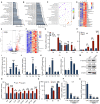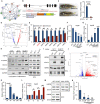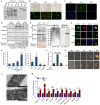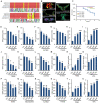An aquatic virus exploits the IL6-STAT3-HSP90 signaling axis to promote viral entry
- PMID: 37099596
- PMCID: PMC10166480
- DOI: 10.1371/journal.ppat.1011320
An aquatic virus exploits the IL6-STAT3-HSP90 signaling axis to promote viral entry
Erratum in
-
Correction: An aquatic virus exploits the IL6-STAT3-HSP90 signaling axis to promote viral entry.PLoS Pathog. 2023 Jun 12;19(6):e1011444. doi: 10.1371/journal.ppat.1011444. eCollection 2023 Jun. PLoS Pathog. 2023. PMID: 37307277 Free PMC article.
Abstract
Viral seasonality in the aquaculture industry is an important scientific issue for decades. While the molecular mechanisms underpinning the temperature-dependent pathogenesis of aquatic viral diseases remain largely unknown. Here we report that temperature-dependent activation of IL6-STAT3 signaling was exploited by grass carp reovirus (GCRV) to promote viral entry via increasing the expression of heat shock protein 90 (HSP90). Deploying GCRV infection as a model system, we discovered that GCRV induces the IL6-STAT3-HSP90 signaling activation to achieve temperature-dependent viral entry. Further biochemical and microscopic analyses revealed that the major capsid protein VP7 of GCRV interacted with HSP90 and relevant membrane-associated proteins to boost viral entry. Accordingly, exogenous expression of either IL6, HSP90, or VP7 in cells increased GCRV entry in a dose-dependent manner. Interestingly, other viruses (e.g., koi herpesvirus, Rhabdovirus carpio, Chinese giant salamander iridovirus) infecting ectothermic vertebrates have evolved a similar mechanism to promote their infection. This work delineates a molecular mechanism by which an aquatic viral pathogen exploits the host temperature-related immune response to promote its entry and replication, instructing us on new ways to develop targeted preventives and therapeutics for aquaculture viral diseases.
Copyright: © 2023 Hou et al. This is an open access article distributed under the terms of the Creative Commons Attribution License, which permits unrestricted use, distribution, and reproduction in any medium, provided the original author and source are credited.
Conflict of interest statement
The authors have declared that no competing interests exist.
Figures







Similar articles
-
An Aquareovirus Exploits Membrane-Anchored HSP70 To Promote Viral Entry.Microbiol Spectr. 2023 Jun 15;11(3):e0405522. doi: 10.1128/spectrum.04055-22. Epub 2023 May 9. Microbiol Spectr. 2023. PMID: 37158746 Free PMC article.
-
Hsp90 Regulates GCRV-II Proliferation by Interacting with VP35 as Its Receptor and Chaperone.J Virol. 2022 Oct 12;96(19):e0117522. doi: 10.1128/jvi.01175-22. Epub 2022 Sep 14. J Virol. 2022. PMID: 36102647 Free PMC article.
-
Display of GCRV vp7 protein on the surface of Escherichia coli and its immunoprotective effects in grass carp (Ctenopharyngodon idella).Fish Shellfish Immunol. 2018 Jan;72:199-209. doi: 10.1016/j.fsi.2017.10.060. Epub 2017 Nov 7. Fish Shellfish Immunol. 2018. PMID: 29102630
-
Targeting Heat Shock Protein 70 as an antiviral strategy against grass carp reovirus infection.Virus Res. 2018 Mar 2;247:1-9. doi: 10.1016/j.virusres.2018.01.005. Epub 2018 Jan 31. Virus Res. 2018. PMID: 29355582
-
Grass Carp Reovirus triggers autophagy enhancing virus replication via the Akt/mTOR pathway.Fish Shellfish Immunol. 2022 Sep;128:148-156. doi: 10.1016/j.fsi.2022.07.069. Epub 2022 Jul 31. Fish Shellfish Immunol. 2022. PMID: 35921937
Cited by
-
Cold-blooded vertebrates evolved regulatory B cells to participate in inflammatory diseases.Cell Commun Signal. 2025 Jun 19;23(1):295. doi: 10.1186/s12964-025-02311-y. Cell Commun Signal. 2025. PMID: 40537793 Free PMC article.
-
GCRV-II invades monocytes/macrophages and induces macrophage polarization and apoptosis in tissues to facilitate viral replication and dissemination.J Virol. 2024 Mar 19;98(3):e0146923. doi: 10.1128/jvi.01469-23. Epub 2024 Feb 12. J Virol. 2024. PMID: 38345385 Free PMC article.
-
Type II grass carp reovirus utilizes autophagosomes for viroplasm formation and subclinical persistent infection.J Virol. 2025 May 20;99(5):e0035225. doi: 10.1128/jvi.00352-25. Epub 2025 Apr 2. J Virol. 2025. PMID: 40172227 Free PMC article.
-
The impact of interleukin-6 (IL-6) and mesenchymal stem cell-derived IL-6 on neurological conditions.Front Immunol. 2024 Jun 24;15:1400533. doi: 10.3389/fimmu.2024.1400533. eCollection 2024. Front Immunol. 2024. PMID: 39015561 Free PMC article. Review.
-
Correction: An aquatic virus exploits the IL6-STAT3-HSP90 signaling axis to promote viral entry.PLoS Pathog. 2023 Jun 12;19(6):e1011444. doi: 10.1371/journal.ppat.1011444. eCollection 2023 Jun. PLoS Pathog. 2023. PMID: 37307277 Free PMC article.
References
Publication types
MeSH terms
Substances
LinkOut - more resources
Full Text Sources
Research Materials
Miscellaneous

